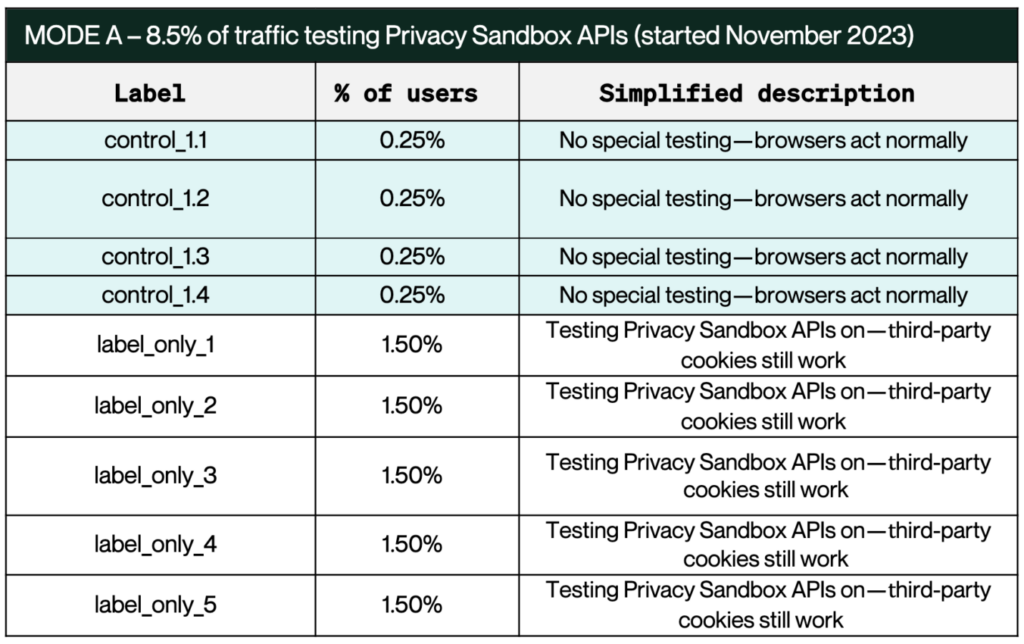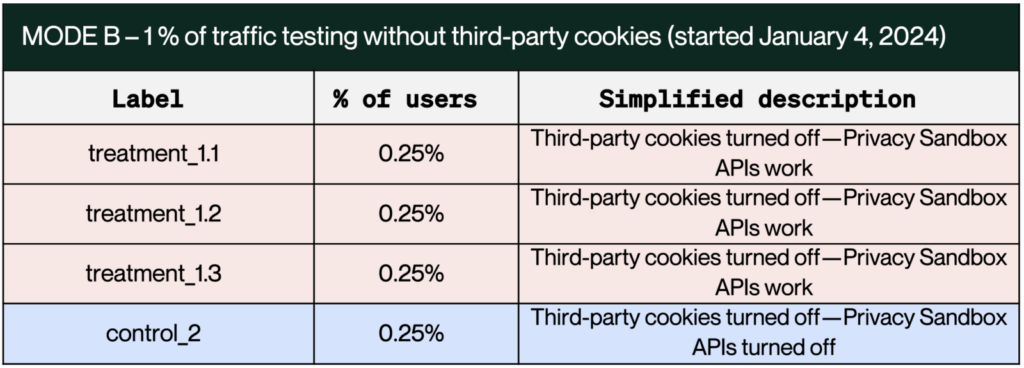Update: As of April 16, 2024, Topics API reporting is also available in the Index UI.
As we work with more publishers to begin implementing and testing new Google Privacy Sandbox solutions, namely the Protected Audience and Topics APIs, we’ve been asked a lot of questions about the APIs and how they will perform. Does ad spend decline on Chrome without third-party cookies? Is Privacy Sandbox helping to replace revenue, and by how much?
To help answer questions like these and provide you with more transparency, we’re introducing two new Privacy Sandbox reporting fields: Protected Audience Status and CMA Label reporting.
Unpacking CMA Label reporting
In collaboration with the UK’s Competition and Markets Authority (CMA), Google has defined two modes of testing for the Privacy Sandbox initiatives, called CMA Label reporting. Each mode consists of various states where Privacy Sandbox features and traditional cookies are selectively enabled or disabled.
This test-based approach opens access to crucial data that sheds light on how Privacy Sandbox APIs impact the advertising ecosystem.
We fully support these efforts and are proactively providing access to the CMA label values observed on our exchange within our customer reporting. You can now delve into specific test groups to compare the performance of Privacy Sandbox APIs against traditional cookie-based methods, providing the insights you need to make informed decisions in our privacy-first world.
CMA Label reporting offers a myriad of benefits, including enhanced transparency, data-driven insights, privacy-centric evaluation, and future-proofed advertising strategies. You can gain a clearer understanding of how Privacy Sandbox proposals perform in real-world scenarios by creating test groups out of limited amounts of traffic.
Here’s a look at how test groups in Chrome are structured with CMA Label reporting:



How Protected Audience Status works
This new Privacy Sandbox reporting feature unlocks reports that can be segmented by Protected Audience (PA) Status, distinguishing between its activation, demand presence, or absence. It streamlines insights into whether the PA API impacts ad demand and delivery.
Protected Audience Status reporting demystifies performance within PA, offering statuses that range from not eligible for a PA auction to successful participation. This granularity enhances our understanding and optimization of private auctions, ensuring they are privacy-compliant and effective.

Privacy Sandbox reporting: the synergy of CMA Labels and Protected Audience Status
Combined, these Privacy Sandbox reporting initiatives allow you to streamline testing and adoption, offering a comprehensive view of campaign performance and engagement. This will allow you to evaluate the effectiveness of new addressability solutions, identify significant changes to your business KPIs, and ensure your advertising strategies remain effective but also privacy compliant.
Coming soon: Topics reporting
We’re also working to build an easy way to collect performance insights around the Topics API. Topics works by assigning consumers to interest-based topics as they browse the web, which can then be used to serve a relevant ad. These topics remain in the browser on the consumer’s device to protect the consumer’s personal information.
We’ll be launching reporting for the Topics API that allows you to understand questions like:
- How are impressions distributed by topic?
- How is revenue distributed by topic?
- How are topic trends changing over time?
For example, the analysis below reports on the topics we’re seeing most often:

The path towards a transparent, privacy-focused digital advertising future is fraught with challenges, but the right tools and insights will help you adapt successfully. As we move forward, we remain committed to fostering transparency and supporting our partners through this shift to a post-cookie landscape.
Learn more about testing Google’s Privacy Sandbox, or if you have any questions, don’t hesitate to contact our team for additional guidance.
Back to blog



